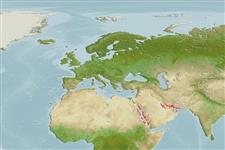Classification / Names
Nombres comunes | Sinónimos | Catalog of Fishes(Género, Especie) | ITIS | CoL | WoRMS | Cloffa
>
Gobiiformes (Gobies) >
Gobiidae (Gobies) > Gobiinae
Etymology: nanus: Name from the Latin 'nanus' meaning small or dwarf, referring to the species' small size among Coryogalops species..
Environment: milieu / climate zone / depth range / distribution range
Ecología
marino; rango de profundidad 1 - 3 m (Ref. 116571). Tropical
Distribución
Países | Áreas FAO | Ecosistemas | Ocurrencias, apariciones | Point map | Introducciones | Faunafri
Western Indian Ocean: Red Sea, Saudi Arabia and Egypt .
Tamaño / Peso / Age
Maturity: Lm ? range ? - ? cm
Max length : 1.5 cm SL macho / no sexado; (Ref. 116571)
Short description
Morfología | Morfometría
Espinas dorsales (total): 7; Radios blandos dorsales (total): 10; Espinas anales 1; Radios blandos anales: 9. This species is distinguished by the following characters: D VI + I,10; A I,9; pectoral-fin rays 12?14, the 2 upper rays with free tips; pelvic fins I,5, joined to form a disc which is emarginate (the shortest branches of fifth ray about 2/3?3/4 length of longest branches of fourth ray), no pelvic frenum; naked predorsal area and area at base of first dorsal fin; longitudinal scale series 26-29; transverse scale series counted forward 6-7, reaching naked area at first dorsal-fin base; transverse scale series counted backward 7-8; circumpeduncular scale rows 11-12; head with 7 transverse suborbital rows of sensory papillae; without tentacle above upper eye margin; anterior nostril is tubular, without flap at its tip, posterior nostril pore-like; semi-translucent body with small scattered orange-yellow spots and speckles, spots in predorsal area and a few midlaterally on body containing black dots; ventral part of body with a row of internal white spots above anal-fin base and on caudal peduncle; head and prepectoral area with small scattered orange to yellowish brown spots; first dorsal fin with 2 broad white bands at the base of fin and distally, middle of fin hyaline densely dotted with melanophores; colour of preserved specimen opaque white to yellowish with sparse melanophores (Ref. 116571).
This species were collected on a patch of rubble-sand bottom in less than one meter to 3 meters deep; found among shells sparsely covering the patch. More material and data are needed to check the relationship of this species to shells and their use as shelters (Ref. 116571).
Life cycle and mating behavior
Madurez | Reproducción | Puesta | Huevos | Fecundidad | Larva
Kovačić, M., S.V. Bogorodsky and A.O. Mal, 2016. A new species of Coryogalops (Perciformes: Gobiidae) and the first adult record of Feia nympha from the Red Sea. Zootaxa 4097(3):341-352. (Ref. 116571)
IUCN Red List Status (Ref. 130435)
Threat to humans
Harmless
Human uses
Más información
PaísesÁreas FAOEcosistemasOcurrencias, aparicionesIntroduccionesStocksEcologíaDietacomponentes alimenticiosconsumo de alimentoRación
Nombres comunesSinónimosMetabolismoDespredadoresEcotoxicologíaReproducciónMadurezPuestaAgregación para la puestaFecundidadHuevosEgg development
Age/SizeCrecimientoLength-weightLength-lengthLength-frequenciesMorfometríaMorfologíaLarvaDinámica larvariaReclutamientoAbundanciaBRUVS
ReferenciasAcuiculturaPerfil de acuiculturaRazasGenéticaElectrophoresesheritabilidadEnfermedadesProcesamientoNutrientsMass conversion
ColaboradoresImágenesStamps, Coins Misc.SonidosCiguateraVelocidadTipo de nataciónSuperficie branquialOtolitosCerebrosVisión
Herramientas
Special reports
Download XML
Fuentes de Internet
Estimates based on models
Phylogenetic diversity index (Ref.
82804): PD
50 = 0.5002 [Uniqueness, from 0.5 = low to 2.0 = high].
Bayesian length-weight: a=0.00708 (0.00333 - 0.01504), b=3.09 (2.92 - 3.26), in cm total length, based on LWR estimates for this (Sub)family-body shape (Ref.
93245).
Nivel trófico (Ref.
69278): 3.0 ±0.3 se; based on size and trophs of closest relatives
Resiliencia (Ref.
120179): Alto, población duplicada en un tiempo mínimo inferior a 15 meses (Preliminary K or Fecundity.).
Fishing Vulnerability (Ref.
59153): Low vulnerability (10 of 100).
